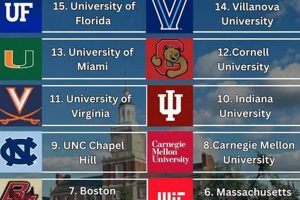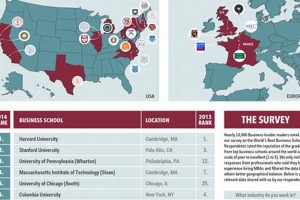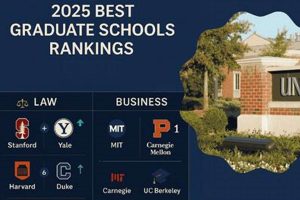Top-tier educational institutions specializing in enterprise architecture (EA) offer comprehensive programs designed to cultivate expertise in aligning business strategy with IT capabilities. These programs typically cover a wide range of topics, from strategic planning and business process modeling to IT governance and risk management. For instance, a curriculum might include in-depth study of frameworks like TOGAF, Zachman, and FEAF, alongside practical application through case studies and real-world projects.
Proficiency in EA is increasingly critical for organizations navigating complex technological landscapes. Skilled enterprise architects play a vital role in optimizing IT investments, fostering innovation, and ensuring alignment between business objectives and technological solutions. The demand for qualified professionals reflects the growing recognition of EA’s contribution to organizational success. Historically, the discipline emerged from the need to manage increasingly complex IT systems and has evolved alongside advancements in technology and business practices.
The following sections will explore key factors to consider when evaluating leading EA programs, including curriculum design, faculty expertise, industry partnerships, and career support services. Further discussion will delve into the evolving role of the enterprise architect and the future of the field.
Tips for Selecting a Top-Tier Enterprise Architecture Program
Choosing the right educational program is crucial for aspiring enterprise architects. The following tips offer guidance for navigating the selection process and identifying institutions that provide a strong foundation for a successful career in EA.
Tip 1: Prioritize Comprehensive Curricula: Seek programs covering core EA domains, including strategic planning, business process management, IT governance, and information security. Look for curricula aligned with established EA frameworks like TOGAF, Zachman, and FEAF.
Tip 2: Assess Faculty Expertise: Investigate the credentials and practical experience of program faculty. Experienced practitioners bring real-world insights and valuable industry perspectives to the classroom.
Tip 3: Evaluate Industry Connections: Strong industry partnerships provide valuable networking opportunities, internships, and potential career pathways. Consider programs with established relationships with leading organizations in the field.
Tip 4: Consider Program Format and Delivery: Evaluate program formats (on-campus, online, or hybrid) and choose an option that aligns with individual learning styles and professional commitments.
Tip 5: Explore Career Support Services: Investigate the career services offered by the institution, including resume writing assistance, interview preparation, and job placement support.
Tip 6: Research Alumni Networks: A strong alumni network can provide valuable mentorship opportunities and insights into career paths within the field of enterprise architecture.
Tip 7: Consider Accreditation and Recognition: Look for programs with recognized accreditations or certifications, which can signal a commitment to quality and industry standards.
By carefully considering these factors, prospective students can identify programs that equip them with the knowledge, skills, and connections needed to excel in the dynamic field of enterprise architecture.
This careful selection process will ultimately contribute to a more informed decision and a successful career path in enterprise architecture.
1. Curriculum Rigor
A rigorous curriculum is a defining characteristic of top-tier enterprise architecture (EA) programs. It provides the foundational knowledge and practical skills necessary for success in this complex field. A well-structured curriculum bridges the gap between theoretical concepts and real-world application, preparing graduates for the challenges of modern enterprise architecture.
- Comprehensive Coverage of EA Frameworks:
Leading programs offer in-depth exploration of established EA frameworks such as TOGAF, Zachman, and FEAF. These frameworks provide structured approaches to EA and are essential for understanding and applying key concepts. Exposure to multiple frameworks equips students with a versatile skill set applicable across various organizational contexts. For example, understanding TOGAF’s Architecture Development Method (ADM) allows graduates to effectively navigate complex architectural transformations within an organization.
- Emphasis on Practical Application:
Beyond theoretical knowledge, rigorous curricula emphasize practical application through case studies, simulations, and real-world projects. These experiences allow students to apply learned concepts, develop problem-solving skills, and gain valuable hands-on experience. For instance, engaging in a simulated business transformation project allows students to apply EA principles in a controlled environment, preparing them for real-world challenges.
- Integration of Emerging Technologies:
The field of EA is constantly evolving. Top programs incorporate emerging technologies like cloud computing, artificial intelligence, and blockchain into their curricula. This ensures graduates are equipped to address the latest technological advancements and their implications for enterprise architecture. Understanding the integration of cloud services, for example, is crucial for modern EA professionals designing scalable and flexible IT infrastructures.
- Focus on Strategic Alignment:
Effective EA requires a deep understanding of business strategy and how IT can support organizational goals. Leading programs emphasize the strategic alignment of IT and business, equipping graduates with the skills to translate business needs into effective IT solutions. This includes understanding how to develop IT roadmaps that align with business objectives and contribute to overall organizational success.
These elements of curriculum rigor contribute significantly to the quality and effectiveness of an EA program. Graduates from programs with strong curricula are well-prepared to navigate the complexities of enterprise architecture, contribute meaningfully to organizations, and advance their careers in this dynamic field. Institutions that prioritize these elements in their EA programs often rank among the best, producing graduates highly sought after by industry.
2. Faculty Expertise
Distinguished faculty expertise is a cornerstone of leading enterprise architecture (EA) programs. The quality of instruction directly impacts the depth of knowledge and practical skills students acquire. Experienced faculty members bridge the gap between academic theory and real-world practice, providing invaluable insights and mentorship.
- Practical Industry Experience:
Faculty with extensive practical experience in EA bring real-world perspectives to the classroom. They offer insights into the challenges and complexities of implementing EA in various organizational settings. For example, an instructor who has led large-scale EA transformations can provide students with practical guidance on navigating organizational change and managing stakeholder expectations. This practical experience enriches the learning experience and prepares students for the demands of the profession. Top EA schools prioritize faculty with proven industry track records.
- Deep Theoretical Knowledge:
A strong theoretical foundation is essential for effective EA practice. Faculty members with deep theoretical knowledge provide students with a comprehensive understanding of EA principles, frameworks, and methodologies. This includes expertise in areas such as strategic planning, business process management, IT governance, and information security. For instance, a professor specializing in TOGAF can provide in-depth instruction on the framework’s intricacies and its application in different contexts. This theoretical grounding enables students to critically analyze and apply EA concepts effectively.
- Research and Publication Record:
Faculty actively engaged in research and publication contribute to the advancement of the EA field. Their work informs curriculum development and ensures students are exposed to the latest trends and innovations. For example, a professor researching the application of EA in cloud computing can integrate these cutting-edge insights into the curriculum, keeping students abreast of current developments. This focus on research ensures the program remains relevant and prepares students for the future of EA. Institutions with faculty actively contributing to the field often attract high-caliber students and maintain strong industry connections.
- Mentorship and Networking Opportunities:
Experienced faculty members serve as valuable mentors, guiding students’ professional development and providing career advice. They can also facilitate networking opportunities, connecting students with industry professionals and potential employers. For example, a professor with strong industry ties can introduce students to leading EA practitioners, opening doors to internships and job opportunities. This mentorship and networking support is crucial for career success in the competitive field of EA.
The collective expertise of the faculty significantly influences the overall quality and reputation of an EA program. Institutions with strong faculty expertise often attract high-achieving students and maintain close ties with industry, contributing to a vibrant learning environment and enhanced career prospects for graduates. The presence of experienced and knowledgeable faculty is a key indicator of a “best EA school,” contributing significantly to student success and the program’s overall standing within the field.
3. Industry Alignment
Strong industry alignment distinguishes top enterprise architecture (EA) programs. Close collaboration with leading organizations provides students with invaluable practical experience, networking opportunities, and insights into current industry trends. This connection ensures curriculum relevance, preparing graduates for immediate contributions to their future employers. For example, partnerships with Fortune 500 companies offering internships or real-world project collaborations provide students with hands-on experience applying EA principles in complex organizational settings. These experiences often translate into a competitive advantage in the job market and accelerate career progression.
Furthermore, industry alignment fosters a dynamic learning environment. Guest lectures by practicing EA professionals, workshops led by industry experts, and site visits to leading organizations expose students to diverse perspectives and real-world challenges. This direct interaction with industry practitioners enhances theoretical understanding and provides practical context for classroom learning. For instance, a workshop on cloud migration strategies led by a cloud architect from a major technology provider offers valuable insights into current industry best practices and the complexities of cloud adoption. Such interactions significantly enrich the educational experience and prepare students for the demands of the profession.
In conclusion, industry alignment serves as a critical differentiator for “best EA schools.” It creates a symbiotic relationship between academia and industry, ensuring curriculum relevance, providing valuable practical experiences, and fostering a dynamic learning environment. Graduates from programs with strong industry ties are well-prepared to meet the evolving needs of the EA profession and contribute meaningfully to organizations from day one. This connection is not merely beneficial but essential for institutions seeking to provide top-tier EA education.
4. Career Resources
Robust career resources are a hallmark of top-tier enterprise architecture (EA) programs. These resources play a pivotal role in connecting graduates with promising career opportunities and fostering long-term professional success. Effective career services contribute significantly to an institution’s reputation as a “best EA school.” A direct correlation exists between the quality of career resources and the success of graduates in securing desirable positions and advancing their careers. For example, a program boasting a high placement rate within six months of graduation, particularly with reputable organizations known for their EA practices, demonstrates the effectiveness of its career support services. This positive outcome reinforces the institution’s standing and attracts prospective students seeking a strong return on their educational investment.
Comprehensive career resources encompass a range of services tailored to the specific needs of EA professionals. These services may include resume and cover letter writing assistance, mock interviews, networking events, and access to exclusive job boards featuring EA-specific roles. Furthermore, some programs cultivate partnerships with leading organizations, creating internship pipelines and direct placement opportunities for their graduates. For instance, a partnership with a major consulting firm specializing in EA transformations could provide students with invaluable internship experiences and potential full-time employment offers upon graduation. Such targeted support significantly enhances career prospects and contributes to the overall value proposition of the EA program.
In conclusion, the availability and effectiveness of career resources are essential factors in distinguishing “best EA schools.” These resources directly impact graduates’ career trajectories and contribute to the long-term success of alumni. Institutions prioritizing career support demonstrate a commitment to student success beyond graduation, solidifying their reputation as providers of high-quality EA education. The strength of career services, therefore, serves as a key indicator of a program’s commitment to producing well-rounded, highly sought-after EA professionals. A comprehensive approach to career development, including personalized guidance and access to relevant industry networks, is integral to the overall success of both the graduates and the EA program itself.
5. Alumni Network
A robust and engaged alumni network is a significant indicator of a top-tier enterprise architecture (EA) program. The strength and reach of an alumni network directly correlate with the perceived value and reputation of the institution. A thriving network offers numerous benefits, including mentorship opportunities, career guidance, and access to a broad professional community. This interconnectedness fosters a sense of shared experience and provides a platform for ongoing learning and professional development. For example, alumni employed at leading organizations often serve as mentors to recent graduates, providing invaluable insights into industry best practices and career paths. This mentorship can significantly impact career trajectory, particularly in a specialized field like EA. Furthermore, a strong alumni network often translates into enhanced job placement rates and career advancement opportunities for graduates. The ability to tap into a network of experienced professionals working in diverse roles and industries provides a significant advantage in a competitive job market. Alumni frequently serve as conduits to open positions, internships, and consulting projects, creating a dynamic ecosystem of professional support.
The active participation of alumni in program development and industry outreach further strengthens the link between the alumni network and the quality of the EA program. Alumni contributions can take various forms, such as guest lectures, participation in advisory boards, and financial support for scholarships and research initiatives. These contributions not only enrich the educational experience for current students but also demonstrate a strong commitment to the program’s ongoing success. For instance, alumni serving on advisory boards provide valuable feedback on curriculum development, ensuring alignment with current industry needs and trends. This ongoing feedback loop contributes to the continuous improvement of the program and reinforces its relevance in a rapidly evolving technological landscape.
In conclusion, a vibrant and engaged alumni network serves as a key differentiator for “best EA schools.” It provides tangible benefits to both current students and alumni, fostering a supportive professional community and contributing to long-term career success. The strength of the alumni network reflects the overall quality and reputation of the program, signaling to prospective students the potential for professional growth and access to a valuable network of experienced practitioners. Therefore, the cultivation and maintenance of a strong alumni network is an essential component of a successful EA program and a key indicator of its commitment to providing a high-quality educational experience and fostering lasting professional connections. The lack of a robust alumni network can be a significant impediment to a program’s ability to attract top students and maintain its standing within the competitive landscape of EA education.
Frequently Asked Questions about Top Enterprise Architecture Programs
This section addresses common inquiries regarding leading enterprise architecture (EA) educational programs. The responses provide clarity on key aspects of program selection and career development within the field.
Question 1: What distinguishes top-tier EA programs from others?
Leading programs differentiate themselves through rigorous curricula aligned with industry standards, experienced faculty with practical expertise, strong industry partnerships, robust career resources, and active alumni networks. These elements contribute to a comprehensive educational experience and enhance career prospects for graduates.
Question 2: How does practical experience factor into EA education?
Practical experience is crucial. Top programs emphasize hands-on learning through case studies, simulations, real-world projects, and internships. This practical application bridges the gap between theory and practice, preparing graduates for immediate contributions to organizations.
Question 3: What role does industry alignment play in program selection?
Strong industry connections are essential. Programs with established partnerships offer valuable networking opportunities, internships, and insights into current industry trends. This alignment ensures curriculum relevance and enhances career prospects.
Question 4: What career support services should prospective students look for?
Robust career services, including resume writing assistance, mock interviews, job placement support, and networking events, are crucial for successful career entry and advancement. These resources demonstrate a program’s commitment to student success beyond graduation.
Question 5: How important is the alumni network of an EA program?
A strong alumni network provides invaluable mentorship, career guidance, and networking opportunities. An active network signifies program quality and fosters a sense of community among graduates, contributing to long-term career success.
Question 6: What emerging trends are shaping the future of EA education?
Emerging trends include the integration of technologies like cloud computing, artificial intelligence, and blockchain into EA curricula. A focus on digital transformation, data governance, and cybersecurity is also increasingly prominent, reflecting the evolving demands of the field.
Careful consideration of these factors will assist prospective students in making informed decisions about their EA education and future career paths. The insights provided offer a framework for evaluating programs and aligning educational choices with individual career aspirations.
The following section will delve deeper into specific program offerings and highlight exemplary institutions known for their excellence in EA education.
Conclusion
Identifying leading enterprise architecture (EA) programs requires careful evaluation of several key factors. Curriculum rigor, encompassing comprehensive coverage of EA frameworks and practical application, is paramount. Faculty expertise, grounded in both theoretical knowledge and practical industry experience, ensures high-quality instruction and mentorship. Strong industry alignment, through partnerships and collaborations, provides invaluable real-world exposure and career opportunities. Robust career resources, including job placement assistance and networking events, are essential for successful career entry and advancement. Finally, a vibrant alumni network offers ongoing support, mentorship, and access to a broad professional community.
The demand for skilled enterprise architects continues to grow as organizations navigate increasingly complex technological landscapes. Selecting the right educational program is a crucial investment in professional development and future career success. Thorough research and careful consideration of the factors outlined herein will empower aspiring EA professionals to make informed decisions and embark on a rewarding career path.







